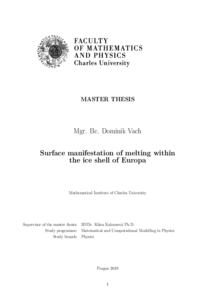Povrchová deformace jako důsledek tání v ledové slupce Europy
Surface manifestation of melting within the ice shell of Europa
diplomová práce (OBHÁJENO)

Zobrazit/
Trvalý odkaz
http://hdl.handle.net/20.500.11956/110084Identifikátory
SIS: 187761
Katalog UK: 990022946730106986
Kolekce
- Kvalifikační práce [11978]
Autor
Vedoucí práce
Konzultant práce
Čadek, Ondřej
Souček, Ondřej
Oponent práce
Velímský, Jakub
Fakulta / součást
Matematicko-fyzikální fakulta
Obor
Matematické a počítačové modelování ve fyzice
Katedra / ústav / klinika
Katedra geofyziky
Datum obhajoby
13. 9. 2019
Nakladatel
Univerzita Karlova, Matematicko-fyzikální fakultaJazyk
Čeština
Známka
Velmi dobře
Klíčová slova (česky)
Europa, tání, volný povrch, plasticitaKlíčová slova (anglicky)
Europa, melting, free surface, plasticityJedno z nejzajímavějších těles sluneční soustavy je Europa, ledový měsíc Jupiteru. Tento ledový měsíc by mohl mít dostatečně příznivé prostředí pro existenci forem života ve svém podpovrchovém oceánu hluboko pod ledovou slupkou. Tato práce zkoumá proces vzniku povrchových útvarů, které jsou nazývány chaotické terény. Tyto obrovské oblasti s narušenou strukturou povrchu, které jedinečně charakterizují povrch Europy, můžou hrát podstatnou roli v porozumění struktury a procesů uvnitř ledové slupky měsíce. Aktuální teorie předpokládají, že chaotické terény vznikají nad vodními rezervoáry umístěnými relativně blízko u povrchu v ledové slupce, nicméně tato hypotéza nebyla zatím ověřena numerickými simulacemi. Cílem této práce je navržení matematického modelu a spuštění simulací pro ověření této hypotézy. Výsledky práce ukazují, že existence vodních rezervoárů pod povrchem aspolečně s procesy uvnitř slupky mohou mít vliv na deformaci povrchu, a tak i vznik chaotických terénů.
One of the most interesting extraterrestrial bodies in the Solar System is Europa, the icy satellite of Jupiter. This icy moon might have a sufficiently hospitable environment which could be harbouring life in the subsurface ocean deep under its icy crust. The thesis thoroughly examines the generation process of one of the surface formations called chaotic terrains. These huge areas of ice disruptions which uniquely characterize Europa's surface might play a significant role in the understanding of the inner structure of the moon. The latest research assumes the chaotic terrains form above liquid water lenses perched relatively shallow in the ice shell, however, no numerical simulations have been performed to confirm this theory. The goal of the thesis is to create a model which would validate the theory and explain the formation process of the chaotic terrains. The thesis runs several simulations, and our results suggest these water lenses and the process in the mantle might play a key role in the chaotic terrains formation.
